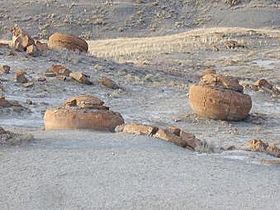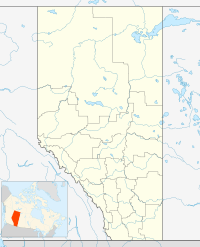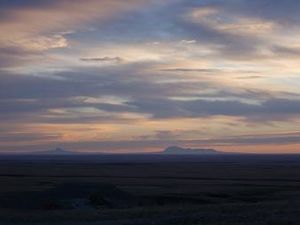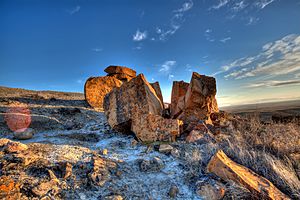Red Rock Coulee facts for kids
Quick facts for kids Red Rock Coulee Natural Area |
|
|---|---|

Large boulders (concretions) at Red Rock Coulee Natural Area
|
|
| Location | County of 40 Mile |
| Nearest city | Medicine Hat |
| Area | 324.15 ha (801.0 acres) |
| Governing body | Alberta Tourism, Parks and Recreation |
Red Rock Coulee is a special natural area in southeastern Alberta, Canada. It's about 54 kilometers (34 miles) southwest of Medicine Hat. This amazing place is famous for its huge, round, reddish rocks. These rocks are called concretions. Some of them are as big as 2.5 meters (8 feet) across!
You can find these giant, round rocks scattered all over the badlands and coulees (which are like small valleys). They are easy to spot along the hiking trails and from the viewpoint on Highway 887. It's a great spot to explore nature and see unique geological formations.
Contents
What Are the Red Rocks Made Of?
The amazing round rocks at Red Rock Coulee are found in a type of rock called the Bearpaw Formation. This rock layer formed a very long time ago, during the Late Cretaceous period. That was when dinosaurs still roamed the Earth!
The Bearpaw Formation is mostly dark gray shale. It also has layers of greenish and gray sandstone and siltstone. You might also see pale gray bentonite and brown ironstone. These different layers create cool bands of color in the exposed badlands.
Over time, wind and water have slowly worn away the softer rocks. This process, called erosion, has uncovered the hard, round concretions. It has also shaped the land into interesting badlands and tall, pillar-like hoodoos.
How the Red Rocks Formed
The concretions didn't form at the same time as the surrounding rock. They grew later, after the sand and mud had settled. Tiny bits of shell, bone, or other natural debris acted like a seed. Then, minerals like calcite and ironstone started to build up around them.
Imagine layers of cement slowly forming around a small center. This is how the concretions grew bigger and bigger. The minerals were carried by water flowing through the ground. The iron minerals are what give these rocks their reddish color.
Because the concretions are made of harder, cemented material, they are much stronger than the surrounding soft rock. This is why they have survived the erosion that has shaped the rest of the landscape. If you look closely, you might even see "growth rings" on the concretions. These show how the layers of cement built up over time. You might also find tiny pieces of the fossils that started the whole process!
Plants and Animals of Red Rock Coulee
Red Rock Coulee is located in a dry, grassy area called the mixed grass and dry mixed grass grasslands. Even though it's dry, many interesting plants and animals call this place home.
Plant Life
Along the coulee walls, you can find plants like sagebrush and juniper shrubs. There are also prickly pear cactus, which have bright flowers and sharp spines. In the uplands, you'll see colorful wildflowers. These include the prairie crocus, gumbo evening primrose, yellow umbrella plant, and broomweed.
Animal Life
Many animals have adapted to live in the dry conditions of Red Rock Coulee. You might spot a white-tailed jackrabbit hopping around. Larger animals like mule deer and pronghorn also live here. Smaller creatures include Richardson's ground squirrel.
Be careful where you step, as there are snakes like the prairie rattlesnake and the bullsnake. You might also see the greater short-horned lizard. A rare find in Alberta is the northern scorpion, which lives in this area.
Many different birds fly over Red Rock Coulee. Look for the fast prairie falcon soaring above. You might also hear the songs of the western meadowlark, Sprague's pipit, and longspur. The rock wren is another bird that likes to live among the rocks.




